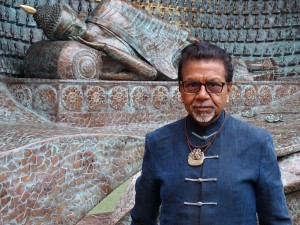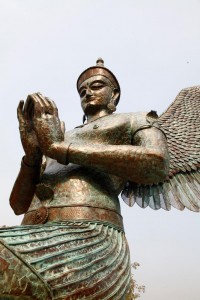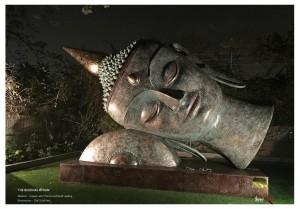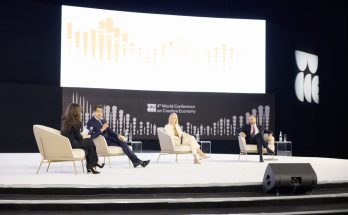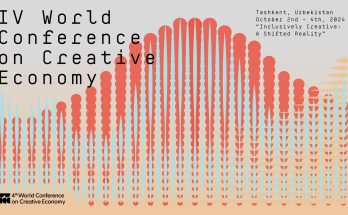When he’s neck deep in work, Satish Gupta loathes being interrupted. That breaks the chain of his thought. But worse than that, it disrupts his meditation. Work to this much-revered artist is meditation and the process of creating art a sacred vocation. At his Zen Space, in the tony part of Gurgaon he has converted half an acre into a retreat for soulful communings. That’s where he reads, writes, sculpts, paints and thinks. Most of his work – barring the early part of his career — has been born in this home studio.
Gupta has taken his creativity to another realm where spirituality and creativity coexists. To those who know him, he is a rare kind of artist who wouldn’t trade his silence and solitude for the flashlight. But he is still chased and celebrated for his work that is cutting-edge and singular. His evolution over the years both as an individual and an artist has been transformative and this is reflective in his body of works.
Gupta’s quest for a deeper engagement with his art has allowed the divinity to come into play in many forms. Not just leading him in his solitude, but protecting him even when he was on his death bed with illness or, in a situation where he could have been wiped away by the fury of nature. All these have been beautifully chronicled by the artist in his work. His life is so woven into the spiritual realm of Zen and he allows that to take him deep into his thought and imagination that often surprises him.
For instance, when the Delhi-born young Gupta set out on a scholarship to Paris back in 1970, he was planning to study graphics. But it was during that period of learning that many things happened to him on an internal and subconscious level. His chance sighting of a Zen book hidden underneath heaps of other books in a nondescript second-hand book shop by the banks of Seine was in some way a turning point in his life. For a young seeker who was perpetually hungry for knowledge the book answered many of his questions that were hovering in his young mind but there were more that even the pages of book could not answer. That’s when Gupta turned to the universe and that again marked another significant phase of his life. His work is a reflection of his life. Many times he surrenders himself to the divinity and allows his work to be led by that same divinity. The result is often surreal. Nothing is the same with Gupta and also his work. He dwells in the richness and expansiveness of the Zen philosophy and brings out a wealth of ideas that are translated into what viewers would plainly term as art. But in the deeper sense, Gupta’s work is beyond art. They resonate something else altogether. Especially his entire collection for Zen Spaces – each is a masterpiece narrating a tale that’s real and personal. He has chosen 72 works and made them into two portfolios of 36 each. In many ways, every piece relieves his life from within and without thus marking his life within the realm of Zen spirit which is to him more than just a belief or a philosophy he subscribes to. It is a way of life – a way that now regulates his life. His depth now comes from it. So is his poise, awareness, stillness, magnitude and even his definition of creativity that does not merely appeal eye but the soul.
His latest solo Zen Space opened on March 24, at Visual Art Gallery in New Delhi. In a conversation with Hoihnu Hauzel, the artist talks about why Zen is his guide and what makes this show so special.
What is it about the Zen philosophy that draws you to such a depth – and then allows you to create art that beholds the viewers? Do you think, in some way, the depth comes from the philosophy?
Zen to me is not just a philosophy. It is a way of life. It is my very being. The Zen philosophy permeates every action that I can choose to take or not take. I am deeply inspired by its simplicity, tranquility, the play of opposites; the rough and the smooth, the nebulous and the steadfast, micro and macro. I like its asymmetry, wabi and sabi – the joy of finding beauty in the most ordinary of objects. It takes me a long time to internalise an experience and then express it in my creative process. For example, in the show Zen Space, the largest sculpture in copper (23 ft. X13 Ft) was inspired by an intense experience I had in Sri Lanka. At the time of the Tsunami, I was supposed to be in a hotel in Gall which was badly damaged by the waves and many people died. I could have been one of them. But due to some goof-up by my travel agent, my booking to that very hotel was not confirmed. So, I went to the hills instead. I was in Dambulla caves surrounded by rock carvings of Buddha, when all hell broke loose. There was news of dead all around but Buddha was serene and calm. I have sculpted this experience with a large reclining head of a Buddha. The back is like a cave with a life-size sleeping Buddha inside it, which is surrounded by 1500 smaller Buddhas. It is like being in the womb, protected, yet the feeling is of freedom and oneness with the beyond. Zen makes me aware of life around me, to experience each moment intensely. To not be judgemental, the good and the bad coexist in life. It makes me conscious of there being no duality.
What is the spirit and thought behind this solo rendition Zen Spaces? How long have you been at it for this show?
Zen Space is about experiencing the Eternal in the now- the present moment, in the endless flow of time. Each moment is complete in itself: the past, present and future are nothing but this moment. In any case, this is all that we have, because past is past, the future is yet to be, but what’s present is NOW!
Your body of works reflects your own internal journey and your mental evolution. For instance, when you returned from Paris, you were drawn to minimalism. Then in Sikkim, after an encounter of sorts with the divinity at Rumtek Monastery, you took to warm and lively shades which are reflective in your work. Tell us, how important is it for you (or as an artist) to keep evolving and experimenting with ideas, work, themes whilst never wavering from a philosophy that you uphold (in your case the Zen way of life).
I don’t want to be a prisoner of my own image. I resist being typecast. When people begin identifying me with my work for too long I change. However, that is not necessarily a conscious decision. It happens naturally. I like to explore, break the rules, and find my own path. In a sense, I am a wandering cloud. For many years, I was painting the sea, the mountains, the clouds, and the moon. Then the figure entered my canvasses in ‘The Eyes of the Thar’. There was a profusion of colour and detail. From a minimalist I became a maximalist. Then there was a transformation again with the Cosmic Matrix where I explored the unity of all religions – then the large sculptures happened with the Surya at T3 International airport and the Devi at The Leela Hotel and several other monumental sculptures. People started asking me if I had become a sculptor from a painter. But I saw no duality between sculpture and painting. The result was my Sculpture-painting where I united the second and the third dimension into one. Life is constantly changing and evolving. I just like to flow with it. But through it all, the essence of my work remains and is evident to the discerning viewer- that being tranquility and repose. But repose is never static. It has its own internal dynamics. In fact, with this show Zen Spaces, movement is very important and is an integral part of this collection. In the sculpture – meditation on a Mandala – it is about nothing being still, each atom in our body and the whole universe constantly in motion and yet movement and stillness, sound and silence are two sides of the same coin. You cannot have one without the other.
At what age in your life did you embrace and engage yourself with the Zen philosophy? Of course, the faith has also helped you tide through during a period of your own illness – but it is definitely a part of your life today. What keeps you going?
I was 21 and on a French scholarship to study art in Paris. The money was very little, just enough to survive. There was nothing left to quench my thirst for knowledge, to satisfy my passion for books. I was wandering aimlessly on the banks of the Seine and I came across a second-hand bookshop. I was browsing in the bookshop and came across a treasure – my first book on Zen, which changed my life. It answered many questions posed by my young mind but more than that it made me ask a thousand more question and thus began my Zen journey. The questions are still there after all these years, but more and more I realise that the questions themselves are the answers, which may be true at a particular moment but not relevant at another time. Life is like a Zen Koan, therefore there are no correct answers.
Zen has helped me to tide over many critical times in my life. For instance, when I was going through brain surgery, it was a little line by Basho, the great Haiku poet, who lifted me. He said that if you have written five haikus in your life, your life is worth having been lived. Till then, I had written many but only three that I was proud of. I did not give up hope. I have, in fact, written many more over a period of time.
Is it easy to differentiate your work before and after your induction into the Zen philosophy?
There is no before or after – there are traces or elements in most of my works of the Zen spirit. Some have it, some don’t. I do not consciously try to infuse them with the Zen philosophy.
You draw and seek inspiration from emptiness and, also different places seem to evoke in you a different level of consciousness that is reflective in your work. How important is meditation for you? Do you meditate before your begin any new work? Share us your process, or if at all there is a method you follow, allow us to a sneak view into your world.
For me every moment is a meditative moment. If you are aware of there being nothing but this moment, every moment is sacred. You don’t necessarily sit in meditation and chant for a specific time every day. Though I must say, if you do so, it would be of tremendous value. But the point is not to end it there and think. “I have done my meditation and my practise for the day and now I am free to go about my business.” This, to me, is wrong. The meditative process is an on-going process. Similarly, the creative process is going on all the time in my mind, in my sleep, in my dreams… it is a ceaseless cycle that has neither beginning nor an end. But before the physical act of creation, I still my mind. I close my eyes and focus on what I need to do and then do it very spontaneously. I enjoy what the Chinese philosophers called the controlled accident, where you only control about 80 per cent of what you want to create and the rest, you simply let happen. It is like, when your grandma cooked a meal not going by the recipe but by instinct, and an extra dash of pepper or sometimes a little less can make the dish special each time. My entire process of creating a work is letting things happen and allow them to grow naturally. Like nature, the emphasis is on creation and destruction and recreation. My etching technique and sculpting process is ideal for this way of thinking. Even for my big sculptures, I do not make detailed scale drawing. They almost create themselves from Shunya-the void. I just facilitate their birth.
You are at home in various mediums and forms of art: painting, sculpting, writing, printmaking, calligraphy. What is the key to your versatility?
I just create. My approach is very holistic. To me, the journey and the sheer joy of creation is the ultimate high. When I cannot sculpt, I paint and when I cannot paint, I write. When I cannot write, I just create in my mind. It is important for me to do that every day in order to keep my mind alive like an athlete keeping his body in form by exercising or a singer practicing ragas every day to keep the voice properly modulated. An artist needs to do that too. He needs to constantly in a frame of mind to create and not be lazy and just wait for inspiration. What is created, whether it is good or bad does not matter – you save the things of any importance and destroy the rest.
Does the fluctuating art market bother you in anyway—when it comes to your own creativity and engagement with your art? How do you deal with the reality that not many art patrons are there to really compensate with the arduous labour of love that many talented artists like you are engaged in?
Art on a grand scale needs patrons and I feel blessed to have some. It has been a long struggle and the struggle still continues. Art is a luxury and at the same time a necessity. It is of tremendous importance to society. It helps in making us sensitise human beings, aware of the beauty of nature and the miracle of being just alive.
Your collaboration with our current Prime Minister for the famed “Om Namo Shivaya” must have led to the opening of many unknown doors for you, in terms of reaching out to a wider audience. Do you think government bodies should engage more artists for such or similar events/activities or even art for public spaces? Do you think the government is not very forthcoming in engaging well-known artists for the cause of real art?
The government needs to do a lot more to make the art scene alive in India. What they are doing is not even a drop in the ocean. We do not even have a decent government museum in the country. Unfortunately, there is too much bureaucracy and very little understanding about art. Art awareness is where we can begin to see some change.
Art market watchers indicated and hinted that the market has shifted from being an investor’s market to a collector’s market. Would you agree? Where do your audience come from: investors or collectors?
I never believe in art as investment. There are better options if you want to invest than investing in art. Collecting art has to be a passion, something that you just need to do. It should be that you bring home a work because you love it. You train your eye; do your research on the artist and then go with your gut feeling. If you are lucky it may bring monetary returns, but what it will surely do is nourish your soul, and that, to me, is the best investment possible.
Author Profile
- Hoihnu Hauzel is a Delhi-based freelance writer. She writes on travel, food and lifestyle.
Latest entries
 CultureMarch 30, 2016Zen and the maestro: Unravelling Satish Gupta’s meditative art
CultureMarch 30, 2016Zen and the maestro: Unravelling Satish Gupta’s meditative art CultureDecember 5, 2013From serene lakes to historic landmarks, Chiang Kai-shek forever in Taiwan
CultureDecember 5, 2013From serene lakes to historic landmarks, Chiang Kai-shek forever in Taiwan TravelSeptember 3, 2013Downturn or upturn, never say no to luxury travel
TravelSeptember 3, 2013Downturn or upturn, never say no to luxury travel TravelAugust 2, 2013In Poland, listening to whispers of history
TravelAugust 2, 2013In Poland, listening to whispers of history

